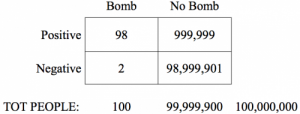Bayes Rule in Terror Security
On the tragic Friday the 13th of November 2015, terror attacks in 6 different locations in Paris killed more than 120 people in the city. The attackers involved in the shooting and bombings were the ISIS extremists who are believed to move into Europe as refugees from Syria. After the incident, European governments have strived to ensure tight security forces and to strengthen monitoring of foreigners against further terror attacks.
Countries, especially the United States and Western Europe, endeavor to prevent bomb attacks in their major cities by all means. One interesting article introduces how the bomb detection could possibly be done in the airport using the Bayes Rule, for example. Bayes believed that the estimated probability of a event depends on the ‘prior belief’ about the likelihood of the event; that is, the key to successful Bayesian reasoning is not having a great sample but rather having an appropriate probability distribution of the frequency for the event. In this example of bomb detection, preconditions are as follows: the airport bomb detector detects the bomb 98% when there is a bomb, and it misperceives a bomb about 1% of the time when there isn’t a bomb.
The table below shows that when 100 of 100,000,000 people do have bombs in their luggages, 98 people get caught and 2 people can pass the test. Also, 999,999 of 99,999,900 people would end up with positive result when they actually do not have bombs.
That being said, the likelihood of positive result when there is a bomb, p(P|B) is 0.98, and the prior p(B) that there is a bomb would be 0.000001. The marginal probability p(P) of showing the positive result would be 0.01 from 98+999,999 positive tests divided by 100,000,000 people. Using the Bayes Rule, the values bring the following result: p(B|P)={p(P|B)*p(B)}/p(P) = 0.98*0.000001/0.01 = 0.000098. Therefore, there is only one hundredth of one percent chance that the positive result means there is a bomb in reality.
However, the problem lies in not only the missed detections, but also the false positives. With this situation where misdetection has to be more carefully monitored in the missing the terrorists, overestimations can be overlooked and likely happen that those who are actually innocent can be accused. The fear of the Paris terror attack is so great that in addition to the misdetection errors, doubts for any tip of suspicion contribute to overestimations. In fact, Muslims and other foreign refugees are suffering from distrusts in the European countries, and thus, efforts of protecting the innocent suspects sacrificed for the fear must be encountered as much as the physical protection of the nations.
Sources:
http://www.zerohedge.com/news/2015-11-14/war-paris-isis-claims-responsibility-deadly-attacks-killing-127-complete-summary-and
http://www.economist.com/node/5354696
http://www.psychologyinaction.org/2012/10/22/bayes-rule-and-bomb-threats/

